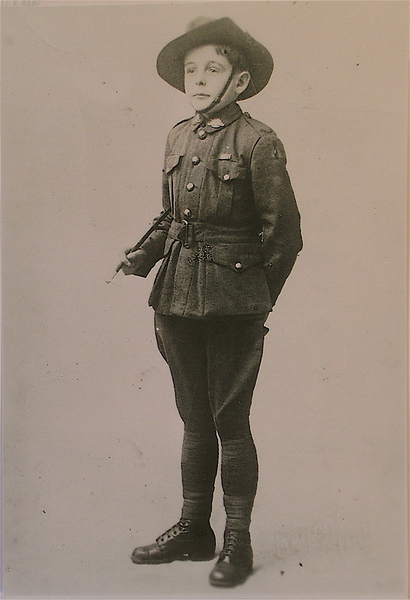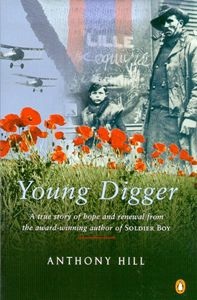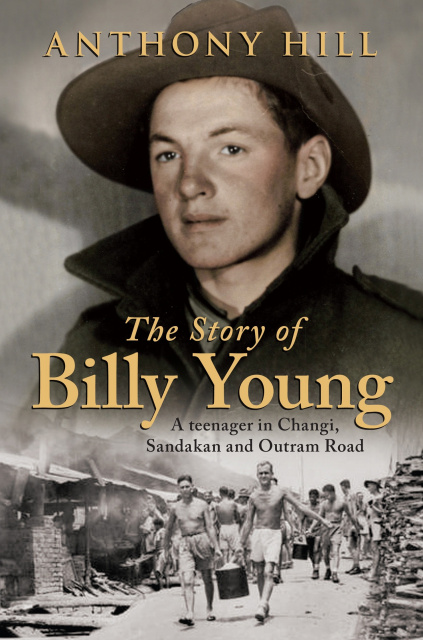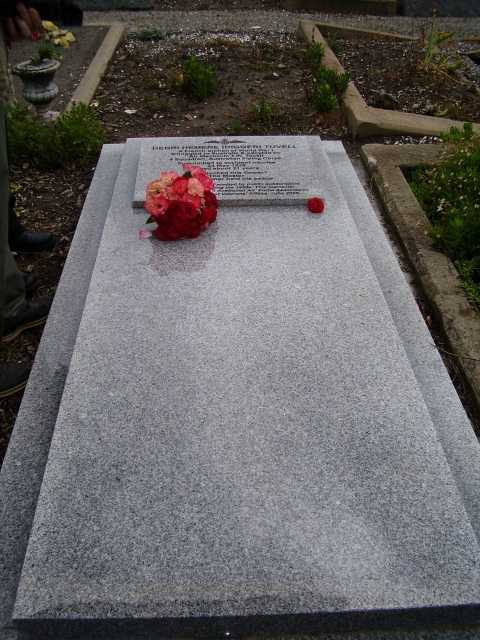… and fallible human memory.
What does an historical novelist do when the document trail in the story you’re writing runs out, and all you are left with is a fallible human memory that cannot recollect the relevant events with any certainty?
For a conventional historian, or even a journalist, the approach may be straightforward enough. You simply say that, after an exhaustive search, the evidence cannot be found ... perhaps offer one or two hypotheses as to the likely course of events ... and move on to the next part of the narrative.

But a novelist writing what is, in essence, a true story, does not have that escape.
One is, after all, telling a tale – and so far as the reader is concerned, stories are not supposed to have unexplained gaps ... holes in the narrative that rarely can be adequately filled by the omniscient author saying 'I don't know what happened here' ... especially if 'here' is a fairly important point in the drama.
Young Digger: 'Henri Tovell', 1919.
A paradox
In most cases my approach has been to adopt the most likely assumption, taking all things into consideration, and point out to interested readers in the Chapter Notes that this is what has been done.
But sometimes where there is a witness still living – albeit one who cannot consciously remember the precise events – this is not enough. At least, not until I have exhausted all attempts to jog my subject's memory.
I strive to be as accurate as I can in the externals of my books: and twice in my career as a novelist I've discovered the paradox that by turning to the techniques of fiction ... by adding speech, thought, emotion, and dramatic movement to the preliminary drafts ... I've been able to stimulate memory to the point where we've been able to get as close to an accurate version of an event as we're likely to get after half or even three-quarters of a century.
Though not so surprising when you think about it: for these are the subliminal elements of story – the human dimension – that can reach furthest into the unconscious to the places where our dreams and memories lie.
And when I say where memories 'lie' – I mean that in both senses of the word. They certainly rest there. But they can also confuse and mislead us, conflating one event with another - compressing time - which is why oral histories always have to be approached with a degree of caution.
But they can also yield, to a diligent author, quite remarkable insights.
Nancy and the 'Plague time'

The first time I used the techniques of fiction to arouse memory was during the composition of my book about the First World War child mascot, Young Digger.
A poignant highlight of the story was a 30-mile buggy ride across the plains to hospital by a mother with her dying two-year-old son. Her elder daughter, Nancy (then seven) was still alive at the time of writing, but had no memory of the nightmare ride and her brother’s death. Perhaps she'd blocked the trauma completely.
I wrote a version, full of colour, hoping it might trigger further memories, as indeed it did.
Nancy remembered she was living on a farm ... the names of the people ... their children ... a carpet snake ... a bushfire. And we realised she probably couldn't remember the buggy ride because she wasn't there. She was in all likelihood being looked after by the people at home.
I wrote a second version using this interpretation as the basis. And it triggered very specific memories. Nancy rang to say she’d remembered that her mother had by then moved to town.
It was a 'sad time' – the 'plague time', a quite particular term she used referring to the Spanish influenza epidemic of early 1919 (and confirmed by references in contemporary newspapers). She remembered her mother having to make pots of beef tea, and of Nancy having to stay at this sad time with the local police sergeant and his family.
It could only have been the time her little brother died. Thus I wrote a third version - still having to make some assumptions - but much nearer the truth than we at first thought possible.
Billy and the Pawpaw

The second time I used the technique was during the writing of The Story of Billy Young, A teenager in Changi, Sandakan and Outram Road.
It concerned an incident where Billy threw a stolen pawpaw to a fellow prisoner-of-war, who swallowed it whole – seeds and all – before the Japanese guards could reach him. He denied the charge. Not a single trace of the fruit was discovered, and the two were let go.
Now Billy's memory is pretty good. Where I could check it against a written record, his version was usually quite accurate.
I tended to accept it, as I did his firm belief that the other POW involved was a feller called ‘Bluey’ Rollason.
Yet when I spoke to Bluey, he rejected it quite forcefully. Other incidents involving pawpaws he remembered: not this one.
Billy was sure it was Bluey. He'd written about it himself. I pressed him, but he was certain ... until he came to read the passage in my manuscript where I'd dramatised the event.
He remembered. It wasn't Bluey after all, but another prisoner, who looked somewhat like him, called Kenny Bird.
I changed the story ... blurring it just a little in case it wasn't Kenny either. But again, it's now a lot more accurate that when we began.
Birth and Death
Now, in the present chapter of my new book, I'm faced with much the same dilemma. The story concerns two mothers, both about to give birth to their fifth child in 1921, and both living in the same house.

Young Digger's grave: Melbourne
With curious parallels to Nancy's story, the first mother died from a recurrence, it appears, of Spanish influenza ten days after her baby was born.
And according to family tradition, the second mother was taken immediately to a private hospital where her baby was born shortly afterwards, for she stayed there only about five days.
The problem is that, according to the public records, the first woman died a fortnight before the second gave birth ... leaving a gap of twelve or thirteen days that I cannot explain.
We have a recorded interview given by the second mother in old age, but she has clearly compressed the events in her mind. There is still a living witness – but alas she cannot remember it, for P Y was the second baby who was born!
She turns ninety-two this weekend.
In one way you may say that these small details don't matter in the overall sweep of narrative, and perhaps I may end up having to gloss them over. It is, as I said, a novel.
But at the present moment it seems important to get them right ... and until I do, I find the composition is jamming. It's a clear case of incomplete research blocking the writer's way forward.
I have one or two steps yet before the trail of documents – birth cerificates, newspaper reports – goes cold. After that I may well have to write a version dramatising these matters of life and death, and hope that the deeper psychological truths of fiction may once again stimulate a memory, hidden in the far recesses of the mind, to reveal the factual truths of a tale from long ago.
The truths of fiction... I like that.
Photo Credits:
'Young Digger', Honoré Hememe (also called Henri Tovell), Anzac Day, London, 1919. Photo courtesy of the late Nancy Elliot and her family.
Book covers: Young Digger and The Story of Billy Young, A teenager in Changi, Sandakan and Outram Road. Courtesy Penguin Books Australia.
Young Digger's grave, Fawkner Cemetery, Melbourne. Author photo.
